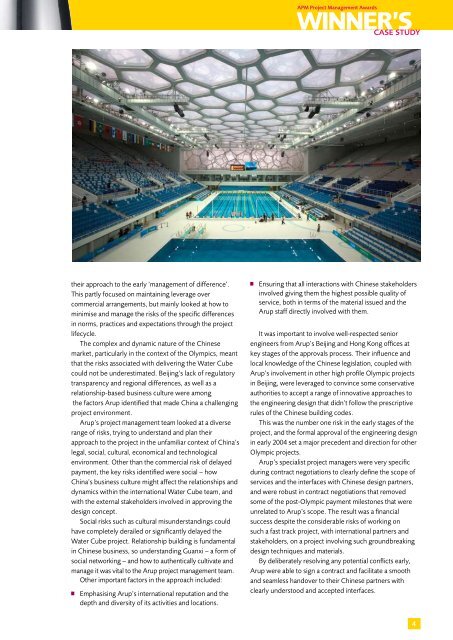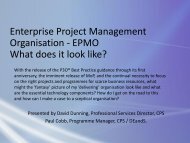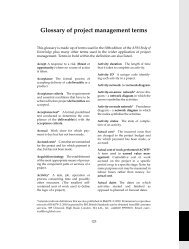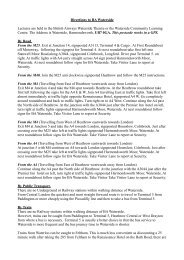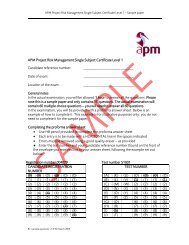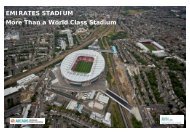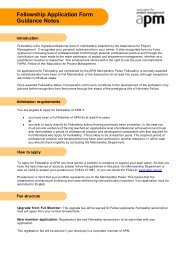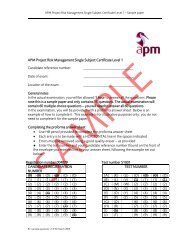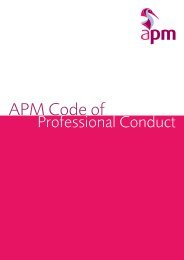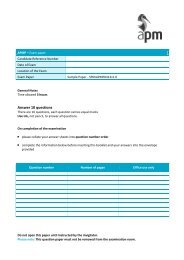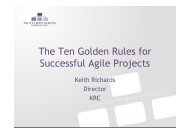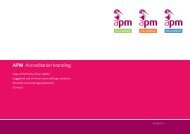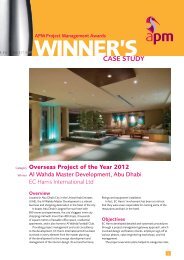Read the full case study here - Association for Project Management
Read the full case study here - Association for Project Management
Read the full case study here - Association for Project Management
Create successful ePaper yourself
Turn your PDF publications into a flip-book with our unique Google optimized e-Paper software.
APM <strong>Project</strong> <strong>Management</strong> Awards<br />
WINNER’S<br />
CASE STUDY<br />
<strong>the</strong>ir approach to <strong>the</strong> early ‘management of difference’.<br />
This partly focused on maintaining leverage over<br />
commercial arrangements, but mainly looked at how to<br />
minimise and manage <strong>the</strong> risks of <strong>the</strong> specific differences<br />
in norms, practices and expectations through <strong>the</strong> project<br />
lifecycle.<br />
The complex and dynamic nature of <strong>the</strong> Chinese<br />
market, particularly in <strong>the</strong> context of <strong>the</strong> Olympics, meant<br />
that <strong>the</strong> risks associated with delivering <strong>the</strong> Water Cube<br />
could not be underestimated. Beijing’s lack of regulatory<br />
transparency and regional differences, as well as a<br />
relationship-based business culture were among<br />
<strong>the</strong> factors Arup identified that made China a challenging<br />
project environment.<br />
Arup’s project management team looked at a diverse<br />
range of risks, trying to understand and plan <strong>the</strong>ir<br />
approach to <strong>the</strong> project in <strong>the</strong> unfamiliar context of China’s<br />
legal, social, cultural, economical and technological<br />
environment. O<strong>the</strong>r than <strong>the</strong> commercial risk of delayed<br />
payment, <strong>the</strong> key risks identified were social – how<br />
China’s business culture might affect <strong>the</strong> relationships and<br />
dynamics within <strong>the</strong> international Water Cube team, and<br />
with <strong>the</strong> external stakeholders involved in approving <strong>the</strong><br />
design concept.<br />
Social risks such as cultural misunderstandings could<br />
have completely derailed or significantly delayed <strong>the</strong><br />
Water Cube project. Relationship building is fundamental<br />
in Chinese business, so understanding Guanxi – a <strong>for</strong>m of<br />
social networking – and how to au<strong>the</strong>ntically cultivate and<br />
manage it was vital to <strong>the</strong> Arup project management team.<br />
O<strong>the</strong>r important factors in <strong>the</strong> approach included:<br />
Emphasising Arup’s international reputation and <strong>the</strong><br />
depth and diversity of its activities and locations.<br />
Ensuring that all interactions with Chinese stakeholders<br />
involved giving <strong>the</strong>m <strong>the</strong> highest possible quality of<br />
service, both in terms of <strong>the</strong> material issued and <strong>the</strong><br />
Arup staff directly involved with <strong>the</strong>m.<br />
It was important to involve well-respected senior<br />
engineers from Arup’s Beijing and Hong Kong offices at<br />
key stages of <strong>the</strong> approvals process. Their influence and<br />
local knowledge of <strong>the</strong> Chinese legislation, coupled with<br />
Arup’s involvement in o<strong>the</strong>r high profile Olympic projects<br />
in Beijing, were leveraged to convince some conservative<br />
authorities to accept a range of innovative approaches to<br />
<strong>the</strong> engineering design that didn’t follow <strong>the</strong> prescriptive<br />
rules of <strong>the</strong> Chinese building codes.<br />
This was <strong>the</strong> number one risk in <strong>the</strong> early stages of <strong>the</strong><br />
project, and <strong>the</strong> <strong>for</strong>mal approval of <strong>the</strong> engineering design<br />
in early 2004 set a major precedent and direction <strong>for</strong> o<strong>the</strong>r<br />
Olympic projects.<br />
Arup’s specialist project managers were very specific<br />
during contract negotiations to clearly define <strong>the</strong> scope of<br />
services and <strong>the</strong> interfaces with Chinese design partners,<br />
and were robust in contract negotiations that removed<br />
some of <strong>the</strong> post-Olympic payment milestones that were<br />
unrelated to Arup’s scope. The result was a financial<br />
success despite <strong>the</strong> considerable risks of working on<br />
such a fast track project, with international partners and<br />
stakeholders, on a project involving such groundbreaking<br />
design techniques and materials.<br />
By deliberately resolving any potential conflicts early,<br />
Arup were able to sign a contract and facilitate a smooth<br />
and seamless handover to <strong>the</strong>ir Chinese partners with<br />
clearly understood and accepted interfaces.<br />
4


